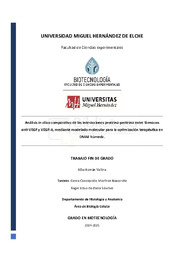Por favor, use este identificador para citar o enlazar este ítem:
https://hdl.handle.net/11000/37065Registro completo de metadatos
| Campo DC | Valor | Lengua/Idioma |
|---|---|---|
| dc.contributor.advisor | Martínez Navarrete, Gema Concepción | - |
| dc.contributor.advisor | Parra Sánchez, Ángel Eduardo | - |
| dc.contributor.author | Román Vallina, Alba | - |
| dc.contributor.other | Departamentos de la UMH::Histología y Anatomía | es_ES |
| dc.date.accessioned | 2025-07-30T10:56:03Z | - |
| dc.date.available | 2025-07-30T10:56:03Z | - |
| dc.date.created | 2025-06 | - |
| dc.identifier.uri | https://hdl.handle.net/11000/37065 | - |
| dc.description.abstract | La degeneración macular asociada a la edad en su forma húmeda (DMAE húmeda) es una de las principales causas de pérdida de visión irreversible en países desarrollados. En su fisiopatología, la neovascularización coroidea mediada por el factor de crecimiento endotelial vascular (VEGF-A) representa un elemento clave. El presente trabajo ene como objevo comparar las interacciones proteína-proteína entre disntos fármacos an-VEGF y la proteína VEGF-A, ulizando herramientas de modelado estructural y acoplamiento molecular (docking). Para ello, se obtuvieron y refinaron las estructuras tridimensionales de los principales agentes terapéucos (Bevacizumab®, Ranibizumab®, Aflibercept®, Brolucizumab®, Faricimab® y Abicipar®), mediante metodologías como el modelado por homología, modelado por fragmentos y ensamblaje estructural. Posteriormente, se idenficaron los sios acvos ulizando aprendizaje automáco con P2RANK, y se llevaron a cabo los análisis de interacción mediante el servidor HADDOCK 2.4. Los resultados obtenidos permieron evaluar la afinidad y estabilidad de los complejos formados, lo cual podría contribuir a opmizar las estrategias terapéucas actuales frente a la DMAE húmeda, facilitando una selección racional de fármacos. Wet age-related macular degeneraon (wet AMD) is one of the leading causes of irreversible vision loss in developed countries. In its pathophysiology, choroidal neovascularizaon mediated by vascular endothelial growth factor A (VEGF-A) plays a key role. This study aims to compare protein–protein interacons between various an- VEGF drugs and the VEGF-A protein using structural modeling and molecular docking tools. To this end, the threedimensional structures of the main therapeuc agents (Bevacizumab®, Ranibizumab®, Aflibercept®, Brolucizumab®, Faricimab®, and Abicipar®) were obtained and refined through methodologies such as homology modeling, fragmentbased modeling, and structural assembly. Acve sites were then idenfied using machine learning with P2RANK, and interacon analyses were performed using the HADDOCK 2.4 server. The results allowed the assessment of the affinity and stability of the resulng complexes, which may contribute to the opmizaon of current therapeuc strategies against wet AMD and support the raonal selecon of an-VEGF drugs. | es_ES |
| dc.format | application/pdf | es_ES |
| dc.format.extent | 40 | es_ES |
| dc.language.iso | spa | es_ES |
| dc.publisher | Universidad Miguel Hernández de Elche | es_ES |
| dc.rights | info:eu-repo/semantics/openAccess | es_ES |
| dc.rights.uri | http://creativecommons.org/licenses/by-nc-nd/4.0/ | * |
| dc.subject | in silico | es_ES |
| dc.subject | interacciones proteína-proteína | es_ES |
| dc.subject | anti-VEGF | es_ES |
| dc.subject | VEGF-A | es_ES |
| dc.subject | modelado molecular | es_ES |
| dc.subject | DMAE húmeda | es_ES |
| dc.subject.other | CDU::5 - Ciencias puras y naturales::57 - Biología::577 - Bioquímica. Biología molecular. Biofísica | es_ES |
| dc.title | Análisis in silico comparativo de las interacciones proteína-proteína entre fármacos anti-VEGF y VEGF-A, mediante modelado molecular para la optimización terapéutica en DMAE húmeda. | es_ES |
| dc.type | info:eu-repo/semantics/bachelorThesis | es_ES |

Ver/Abrir:
TFG_Alba_Roman_Vallina.pdf
3,44 MB
Adobe PDF
Compartir:
 La licencia se describe como: Atribución-NonComercial-NoDerivada 4.0 Internacional.
La licencia se describe como: Atribución-NonComercial-NoDerivada 4.0 Internacional.
.png)